While the conversion of an analog signal into a binary signal, the PCM (pulse code modulation) technique is used. But this system has a disadvantage like it requires large bandwidth because all the bits are going to be transmitted and there is a difference between the analog signal and the digital signal. So these can be overcome by using Delta modulation. It is one type of technique used for the conversion of an analog signal into a digital version.
The definition of delta Modulation is the signal conversion technique from analog to digital and digital to analog. This technique prefers where the signal quality is not an important parameter. Differential pulse code modulation uses the predictive waveform coding technique for signal conversion. The same technique also applied by using this modulation process. In this modulation, the sampling rate is higher to reduce the number of steps to decrease the bandwidth of the signal. It is a one form of the differential pulse code modulation (DPCM) and can be called as 1-bit DPCM.
Working Principle of Delta Modulation
Delta modulation process compares the present sample value to the previous sample value. Based upon the difference amplitude is going to be increased or decreased by step signal. If the amplitude is increased then step size increased by one step i.e., +Δ and bit 1 are generated. If the amplitude is decreased then step size is reduced by one step i.e., -Δ and bit 0 is generated.
Circuit Diagram using IC
This modulation technique has a transmitter and receiver for converting the analog signal to digital and digital to analog form for transmitting the information. The circuit diagram of this modulation using IC is shown below.
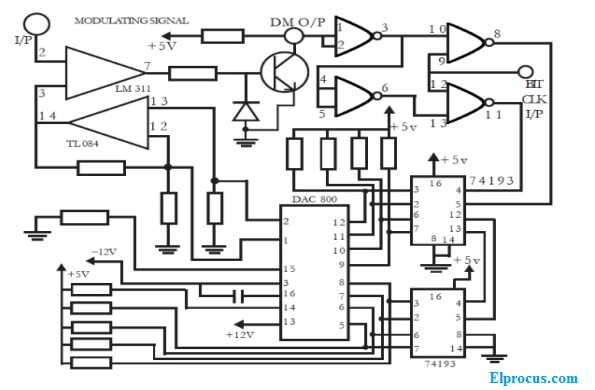
tx-using-ic
The receiver circuit diagram of this modulation is shown below.
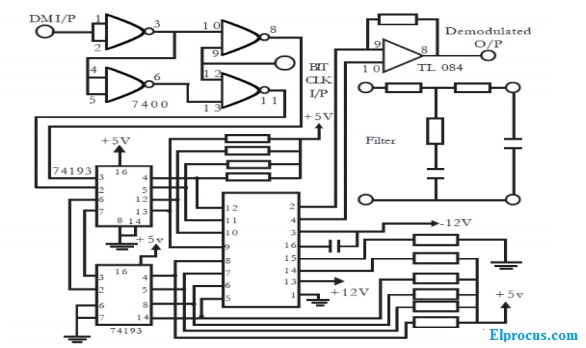
rx-using-ic
The following transmitter block diagram of delta modulation is shown below.
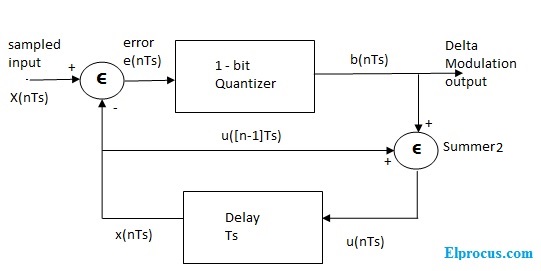
transmitter-block-diagram-of-delta-modulation
The following receiver block diagram of delta modulation is shown below.
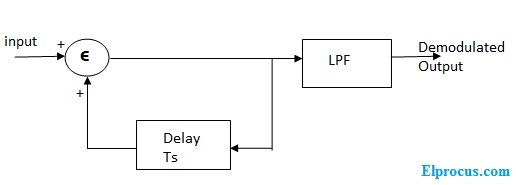
receiver-block-diagram-of-delta-modulation
In the transmitter section of the modulation block diagram, the lower part of the delay circuit block and summer2 are called as the accumulator.
In the Transmitter Section
- Present sample value is X(nTs)
- The previous sample value is u([n-1]Ts)
- e(nTs) is an error signal between the present sample and previous sample
- b(nTs) is the quantizer output signal
The accumulator block summer2 adds the quantizer output signal and previous sample approximation, and this results in u(nTs). The previous sample is achieved by delaying the present sample period approximation.
u(nTs)=u([n-1]Ts) + b(nTs)
“Present sample value X(nTs) and staircase approximated signal x(nTs) both are subtracted to know the error signal e(nTs). If e(nTs) is positive, then the one-bit quantizer circuit increase the step size +Δ and bit 1 is transmitted. If the error is negative, then step size is reduced by –Δ and bit 0 is transmitted to the output.”
In the Receiver Section
In the block diagram of this modulation, the summer block and delay circuit block are called as Accumulator. And accumulator generates the staircase approximated signal with having delayed by one sample period of Ts.
“The accumulator’s generated delayed signal is added to the input signal to this modulation receiver block diagram along with the delta modulated output sequence. And if the delta modulated output sequence is 1, then the delayed signal is increased by +Δ and if the sequence is 0, then the staircase approximated signal is reduced by –Δ. And the final staircase approximated signal is forwarded from the low pass filter (LPF) to recover the original signal X(nTs)”.
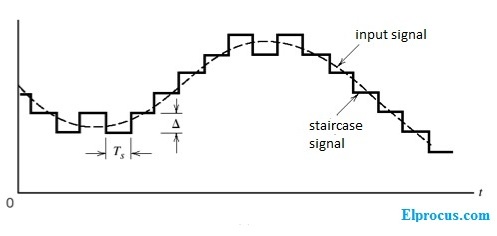
output-waveform
The above diagram shows this modulation waveform. Here, the staircase signal is compared with the input sampled signal, based upon the principle of delta-modulation step size may be increased or reduced and the binary sequence is generated.
Know more about Digital Modulation MCQs.
The advantage of delta modulation is, this process transmits only one bit either 1 or 0 per one sample. So, it requires lower channel bandwidth than the PCM & the signaling rate also small because it generates only one bit per one sample. So the drawbacks of PCM can be overcome by using this modulation. Here is a question for you, what are the applications of delta modulation?